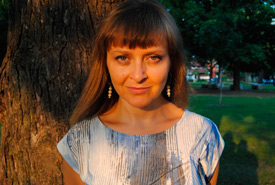Connecting to nature through art

Teva Harrison (Photo by David Leonard)
It’s been said that there are two types of people in the world, and which side you fall on comes down to one simple question of how you see a glass of water. The hypothetical glass sitting on Teva Harrison’s drawing table is filled with the clear liquid swirled with paint, alongside sketches that have become the basis for her graphic memoir, In-Between Days, about her life living with metastatic breast cancer.
Her glass might seem half-empty, but if you ask her, it’s spilling-over-the-brim full.
Harrison, a true optimist, is a force in her own right. The Nature Conservancy of Canada’s former director of marketing, her lifelong connection with art and nature is one of the things that help her through tough days. We talked with Teva about how art has helped her share her story of living with cancer and her lifelong love for nature.
The Nature Conservancy of Canada (NCC): What role does art play in connecting us with nature?
Teva Harrison (TH): We have this tremendous history of drawing and painting landscapes and people communing with nature through art. Art is at its best when it’s a lens through which we better see what we’re looking at; it’s a way of looking closer and making something your own.
I absolutely would say that art connects people with nature by the act of doing [producing art]. For someone else, they may look at the art and can connect with a natural area. It’s a beautiful dialogue and it’s so central to the Canadian experience of nature — especially wilder, more remote areas. For example, the Group of Seven has connected with northern Ontario, while Emily Carr has made the northwest accessible through her art.
I also wanted to mention/acknowledge the strong contributions of our First Nations’ art, not just to our understanding of what Canada was through the study of traditional art, but of what Canadian art is. Yes, in the totem poles and villages Emily Carr painted, but much more so when you look at the totem poles themselves. Or, the powerful work of artists like Norval Morrisseau and Kenojuak Ashevak, and young artists like Caroline Monnet and Jordan Bennett, and so many more young artists carrying forward a long tradition of interpreting the world through art into new media in a powerful way that challenges our thinking.
I grew up in a forest between the mountains and the ocean, with rivers in between. My childhood was all about nature. We always took our sketch pads with us to draw. Our days would disappear in the best possible way.
When I got sick, drawing images of tiny flowers I had photographed while in the Arctic provided solace, because it’s how I grew up connecting to the world around me. And drawing is a really basic way of sorting out my relationship with the world.
When I was diagnosed with cancer, my relationship with the world was challenged in the deepest way. I started falling back on nature, and on these images of Arctic flowers that persist under the harshest conditions. I found them really inspiring.
I also started placing myself in the continuum of the world — not thinking of myself in the centre of things. In nature, there is birth, life and death. That’s a perspective nothing else can provide.
NCC: You’ve started drawing on an iPad recently, rather than on a drafting table. What are the opportunities for technology, art and nature to intersect?
TH: I’ve started to use an iPad Pro when I can’t sit at my drafting table. So I’m able to still draw by using this little portable device. There are new programs with fantastic drawing tools these days.
The way you produce the art is a different experience, but the output can be quite similar. It’s great to be able to throw something small in a bag and go draw. Because a new generation is growing up so digitally, this provides them with an opportunity to connect with the natural world. The technology is so incredibly accessible.
I take my tablet with me when I travel. I can still work out my thoughts in a much smaller scale, because usually I work on a quite large canvas. But I also travel with my sketch pad. I guess there’s a bit of a danger to having technology in nature. I would prefer to be out in nature. I like to put away my phone and tablet, take photos and work from them later. We have so few opportunities to be still.
So I guess I’ve come full-circle in my argument — there are great opportunities, but I wouldn’t want to lose sight of just being.
NCC: What landscape do you connect with the most?
TH: There are so many beautiful landscapes that it’s overwhelming to try and think about just one. But I grew up in the mixed coniferous forest with mountains and rivers, and I never feel so at home as when I’m in that landscape. There’s something about home place — it’s where I learned which plants are safe, which are toxic and when the wild strawberries are ripe enough to eat.
And that’s come full circle in The Joyful Living Colouring Book — there are drawings of Arctic flowers in there too. After my memoir came out (In-Between Days), we were discussing what was next and were chatting about how the flowers were the catalyst for getting me back to making art. It just felt right — perfect.
NCC: Do you have any advice for people who might want to try their hand at making art, perhaps to connect with nature?
TH: Very few people pick up a pen and know what they’re doing [right away]. It takes practice and doing something badly to do it well, and repetition. You don’t have to show your work to others if you don’t feel comfortable at first. The very act of looking closely and communing with nature could be enough. But don’t be too hard on yourself. So often we’re impatient — we want things now and we want them to be perfect. But they may enjoy going through the iterative process, doing the work and taking their time.
The same goes for writing: if you want to write, sit down and write. It’s about doing the right thing until the right time comes along.
This story originally appeared in the Winter 2017 issue of the Nature Conservancy of Canada Magazine. To learn more about how you can receive the magazine, click here.




